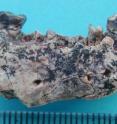New fossil primate suggests common Asian ancestor, challenges primates such as 'Ida'
Related images
(click to enlarge)
Pittsburgh, PA…According to new research published online in the Proceedings of the Royal Society B (Biological Sciences) on July 1, 2009, a new fossil primate from Myanmar (previously known as Burma) suggests that the common ancestor of humans, monkeys and apes evolved from primates in Asia, not Africa as many researchers believe. A major focus of recent paleoanthropological research has been to establish the origin of anthropoid primates (monkeys, apes and humans) from earlier and more primitive primates known as prosimians (lemurs, tarsiers and their extinct relatives). Prior to recent discoveries in China, Thailand, and Myanmar, most scientists believed that anthropoids originated in Africa. Earlier this year, the discovery of the fossil primate skeleton known as "Ida" from the Messel oil shale pit in Germany led some scientists to suggest that anthropoid primates evolved from lemur-like ancestors known as adapiforms.
According to Dr. Chris Beard–– a paleontologist at Carnegie Museum of Natural History in Pittsburgh, Pennsylvania and a member of the international team of researchers behind the Myanmar anthropoid findings––the new primate, Ganlea megacanina, shows that early anthropoids originated in Asia rather than Africa. These early Asian anthropoids differed radically from adapiforms like Ida, indicating that Ida is more closely related to modern lemurs than it is to monkeys, apes and humans.
The 38-million-year-old Ganlea megacanina fossils, excavated at multiple sites in central Myanmar, belong to a new genus and species. The name of the new species refers to a small village, Ganle, near the original site where the fossils were found, and the greatly enlarged canine teeth that distinguish the animal from closely related primates. Heavy dental abrasion indicates that Ganlea megacanina used its enlarged canine teeth to pry open the hard exteriors of tough tropical fruits in order to extract the nutritious seeds contained inside.
"This unusual type of feeding adaptation has never been documented among prosimian primates, but is characteristic of modern South American saki monkeys that inhabit the Amazon Basin," says Dr. Beard. "Ganlea shows that early Asian anthropoids had already assumed the modern ecological role of modern monkeys 38 million years ago."
Ganlea and its closest relatives belong to an extinct family of Asian anthropoid primates known as the Amphipithecidae. Two other amphipithecids, Pondaungia and Myanmarpithecus, were previously discovered in Myanmar, while a third, named Siamopithecus, had been found in Thailand. A detailed analysis of their evolutionary relationships shows that amphipithecids are closely related to living anthropoids and that all of the Burmese amphipithecids evolved from a single common ancestor. Some scientists had previously argued that amphipithecids were not anthropoids at all, being more closely related to the lemur-like adapiforms.
The discovery of Ganlea strongly supports the idea that amphipithecids are anthropoids, because adapiforms never evolved the features that are necessary to become specialized seed predators. Indeed, all of the Burmese amphipithecids appear to have been specialized seed predators, filling the same ecological niche occupied by modern pitheciine monkeys in the Amazon Basin of South America. During the Eocene when Ganlea and other amphipithecids were living in Myanmar, they inhabited a tropical floodplain that was very similar to the environment of the modern Amazon Basin.
Source: Carnegie Museum of Natural History
Other sources
- New Fossil Primate Challenges "Missing Link" Idafrom Science NOWWed, 1 Jul 2009, 21:56:03 UTC
- Myanmar fossil may shed light on evolutionfrom AP ScienceWed, 1 Jul 2009, 16:49:07 UTC
- New fossil primate suggests common Asian ancestor, challenges primates such as 'Ida'from PhysorgWed, 1 Jul 2009, 9:14:04 UTC
- New Fossil Primate Suggests Common Asian Ancestor, Challenges Primates Such As 'Ida'from Science DailyWed, 1 Jul 2009, 1:35:04 UTC
- Human ancestor may be from Asia, not Africafrom MSNBC: ScienceWed, 1 Jul 2009, 0:21:11 UTC


